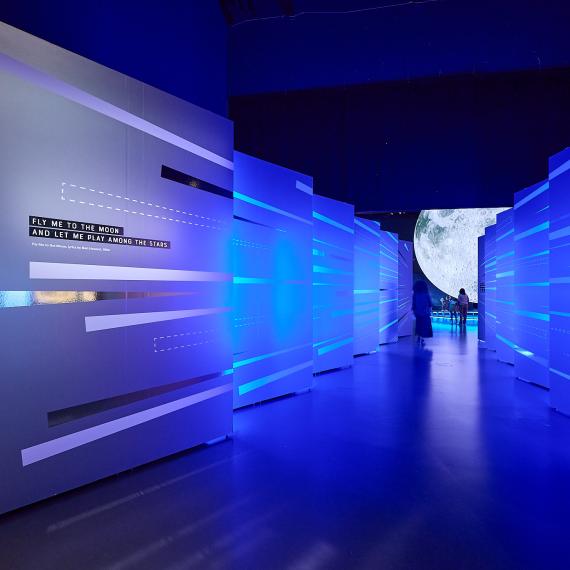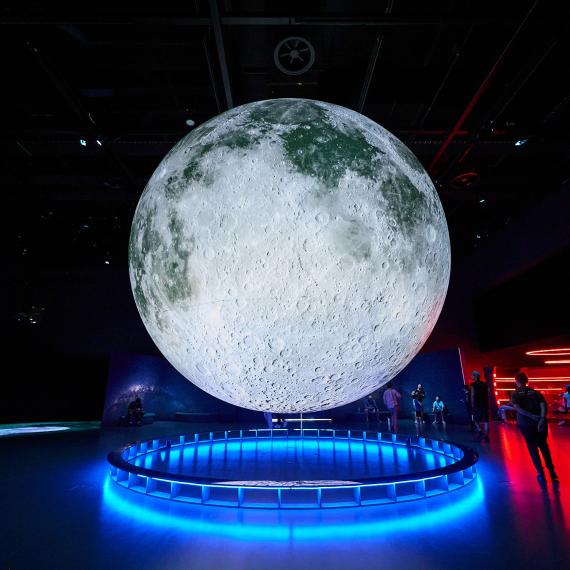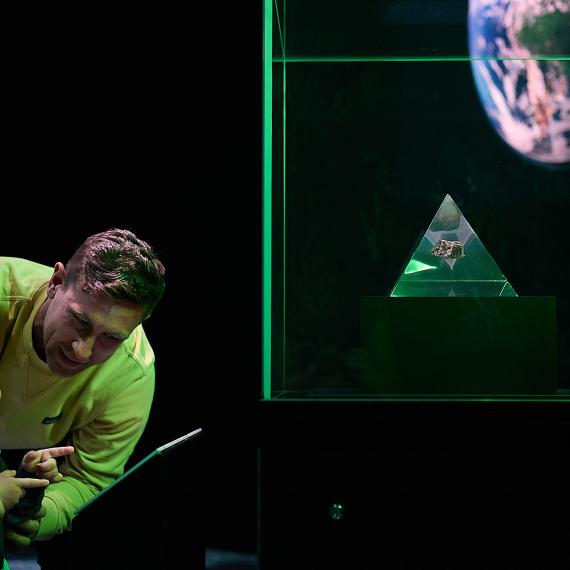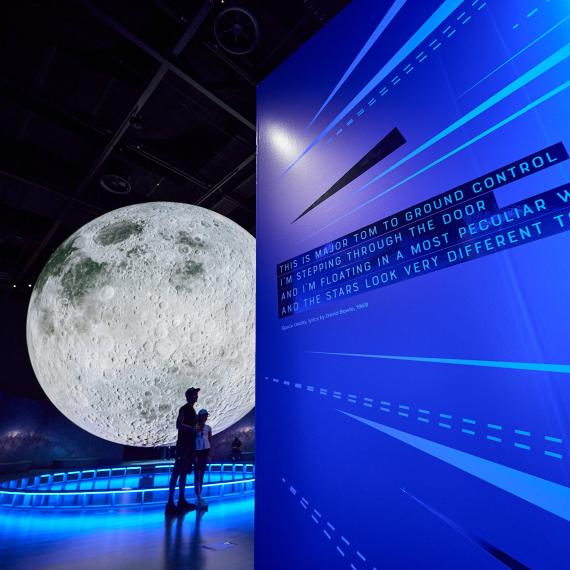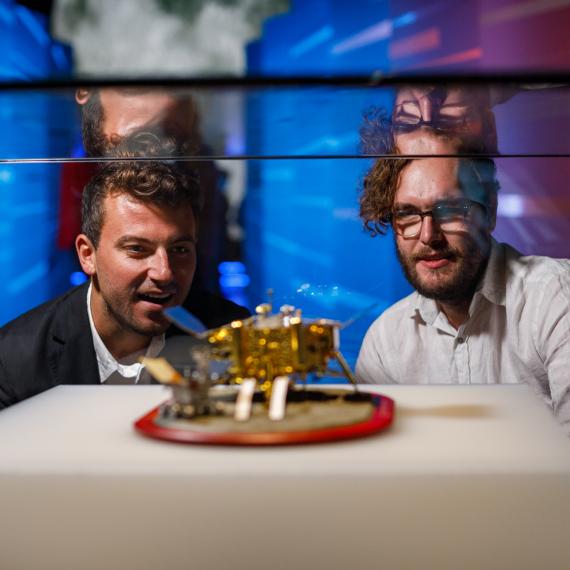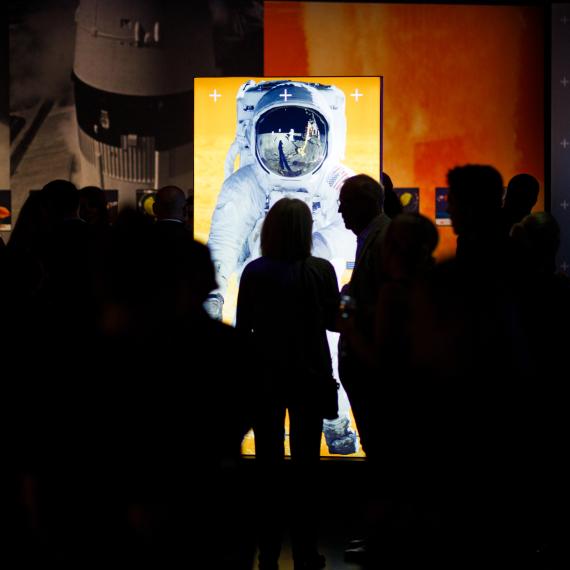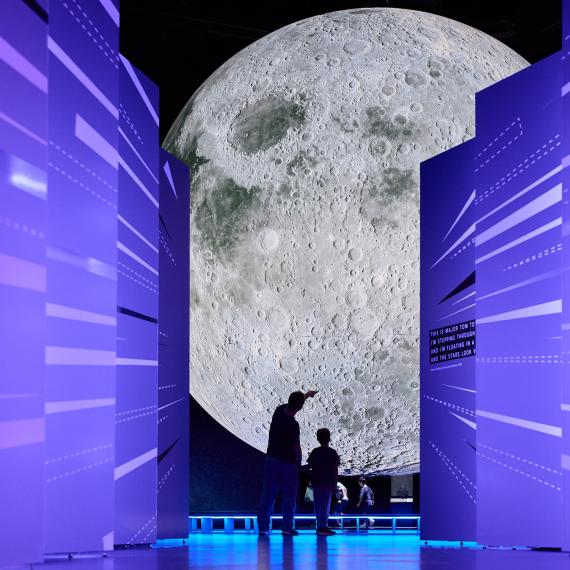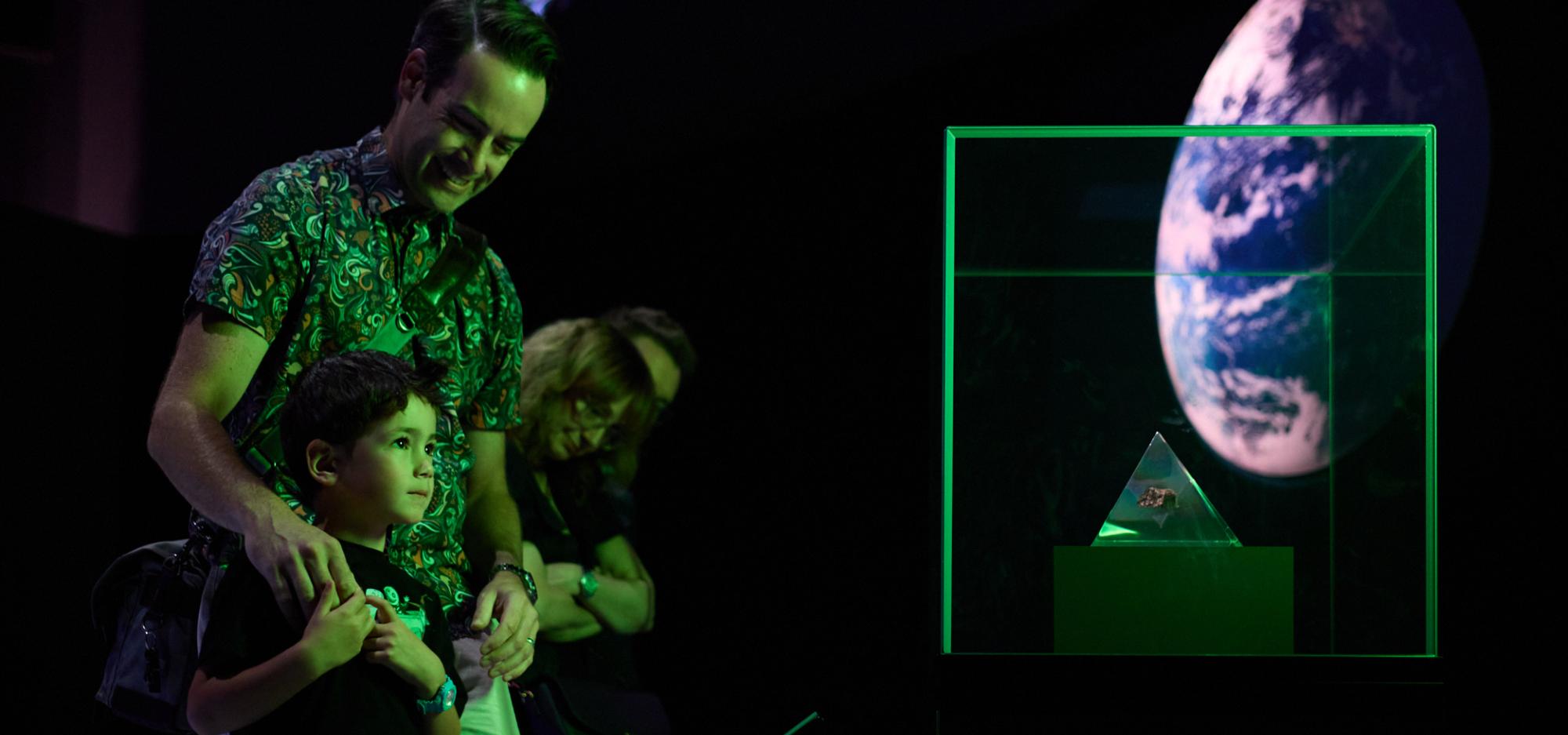
Opportunities of a Western Australian space economy with Dr Benjamin Kaebe
Opportunities of a Western Australian space economy with Dr Benjamin Kaebe Join Dr Benjamin Kaebe, an engineer, researcher and teacher, as he discusses the opportunities of a Western Australian space economy.
-
Episode transcript
Welcome to In Conversation, a series brought to you by the Western Australian Museum Boola Bardip. In conversation is a safe house for difficult conversations and passionate and thought provoking public dialogs that tackle big issues and difficult questions, led by some of the most brilliant minds. In conversation is recorded on Whadjuk Noongar Boodja. The Western Australian Museum acknowledges and respects the traditional owners of their ancestral lands, waters and skies.
Hello everyone and welcome to the Luna Lounge. And before we begin, I'd like to acknowledge the traditional custodians of the land, the Whadjuk Noongar, the traditional owners of the land we meet on today and pay my respects to elders past and present. This evening we are joined by Doctor Benjamin Kaebe, who over the next 30 minutes is going to be taking us through opportunities for a Western Australian space economy.
Welcome Dr. Ben.
BK: Hello. I'm very excited to be here. I hope everybody's excited to see the moon and also to see what's going on here in Western Australia in terms of the space sector. I'm with my own company Aneutronic, which I'm representing today, and I want to talk today (This works. No, it doesn't work now. Now it works) about the opportunities for a space economy here in Western Australia. First, the boring part. Who am I? This will be hopefully not too long. I am a visionary leader in the space sector. An entrepreneur with a couple of high tech projects, especially in the space sector, but also others. And also related to the space sector. And I'm the self-proclaimed space champion of Western Australia. We have an infancy of the Western Australian Space Agency or space economy here and there's still a lot work to do. And I don't believe that the government or academia can alone stem this to a degree where we have actually something meaningful. I'm the chairman and founding director of Aneutronic, a company doing consulting in hi tech space technology for entrepreneurs, for inventors and investors.
I'm from Germany, as you can hear from my accent, I guess. I studied in Germany, an elite degree in engineering and science, at the Technical University in Berlin. Bachelor's and Master's. Afterwards I started a job as design engineer for ventricular assist devices, where I hold a couple of patents. Worked in afterwards for Volkswagen as key account manager, looking after all the pumps and fluid machines in Wolfsburg. And was then invited in 2015 by the Austrian Defense Force Academy to do my aerospace engineering degree PhD in Canberra.
I developed a system to measure temperature and shock wave phenomena, with a laser spectroscopy system. The system was in the end capable to measure 1.6 million times per second the temperature at certain locations. I have a couple of applications with that. I then moved to Perth because I wanted to live in Perth. There’s perfect weather here. Western Australia's the best country, best state in the world. And, yeah, so I'm living here now. I worked initially at the University of Western Australia as a research associate in quantum physics. Moved in and out of academia because I want to earn money. Worked at FMG for a while before FFI was formed, where I wrote for Twiggy Forest, the hydrogen optimization method, which took weather data from certain locations into account. I then predicted for the next 30 years weather patterns and then wrote a program which could sort of optimize a facility to, you know, the different parts of the facility, from solar panels to air separation units and so on, how to make hydrogen as cheap as possible. I then left because I told them it's not working, and then he formed FFI.
Hydrogen is not a good vector for energy. It's just good for the oil and gas sector, so it's a bit of a of a shame. But anyway, I then was poached by Fugro. They've got an Australian space agency grant to build the space automation robotics complex here in Perth. Pretty much remotely operating spacecraft and robots in space, which in my eyes, will be a very important part at some point, but not now. So it's not the right pathway to build a sustainable space economy, which I'm about. So I moved out of there as well in 2021, so in the middle of Covid, and formed my own company, Aneutronics as I said. And also, working now on a bigger project in Western Australia to build an infrastructure to actually kickstart the economy.
I have over two decades experience in complex projects, as you can already guess, I think, and now I'm dedicated to grow the space sector, especially here in Western Australia. Okay, but first of all, what is the new space race? I think everybody has heard about the Apollo missions. Last week we had Denail Obreschkow talking about Apollo and the last half of the century, like 1950s. We had a space race between the Soviet Union an, USA. They wanted to reach the moon and obviously put a lot of money into this, and that kickstarted a very strong development for the space economy. After Apollo was sort of canned in the, with Richard Nixon, he wanted the space shuttle because he wanted to deliver things into space. You don't need a space shuttle to deliver things in space, it’s to collect things in space. But that's a different story. And the space shuttle was more or less ruining the space race at the time. Because with the space shuttle it was very expensive to bring anything in LEO, in low-Earth orbit. About $63,000, US dollar, per kilogram. So then we had a couple catastrophes as well with the space shuttles. Two, where in the last one all the astronauts died, and that was more or less it for the space sector.
Then came the emergence with Elon Musk. He wants to make us an interplanetary species, and that's why he was building SpaceX. Everybody thought it's a dream. He wanted to build a new rocket system, which was reusable, and that was actually leading now into the next space race. Now we want to get back to the moon, we have the Artemis program. China wants to build a permanent base on the moon as well. And that is now what we need, sort of, to get there.
And who asked for that? For what that is. That's not just for research, for the opportunities, the opportunities on the moon, I will talk about them a little bit later. But why do we need space technology? So I can be, I can be very boring, like most people who then talk about Oh we need GPS systems and we have mobile systems and communication and so on. And I've written it down here, as you can see. But the real advantage, as I explain it this way, imagine you have a room, you know like this big and you solve problems here. That's the only thing what you do. You don't solve problems in the in the entirety of the universe. So everybody says, well, why do we go out there? We have so many problems on Earth. But I can tell you, if you solve problems in the big room, you automatically solve problems in the small room. So an example is going to Mars. There's problems going to Mars energy wise. We don't have water, we have to bring that with us. We have to grow plants there. I think everybody has seen The Martian, or at least heard about it.So if we solve these problems, we can grow crops in the desert, for example. So we can solve a lot of problems on Earth. We can use the technology to capture carbon, or other things, to actually geoengineer our planet back to a place and state which we need to be sustainable.
However, there is a big problem in the moment in the space sector, and that's called the bottleneck, for accessing space. So the bottleneck means we have a lot of companies who want to go to space. Some of them have the means and the money to do so, but even those faced the problem that they can't, there's not enough transportation methods in the moment to actually go to space. The whole world is reading the data a little bit different than I, I don't want to say wrong, but I think it's wrong. They want to go to space with light rockets. Light rockets they're good to, you know, snipe one thing into low-Earth orbit. But the problem is if you deliver a lot of goods would you do that with a with a bicycle? You take a big truck and you put lots of stuff in that and then you deliver. This is how you bring the price down. And that's what SpaceX is doing.
Anyway, the space economy is already thriving in the moment. Here's a chart, a couple of charts, which I took from the McKinsey report in 2022. They are just comparing different years, or different decades, and make a prediction for the future. First of all, what you can see here is that we have already, compared to 2010 to 2022. Most of the numbers are doubling, and the prediction from 2022 to 2030 is that the numbers will double again. Just the space market size, we are talking about in 2030 about a space economy which is worth $1 trillion. Which means there's a lot of opportunities. I don't want to bore you with all of the rest of the numbers, but I think the important ones are here. The satellite cost, they went down mainly driven by the last part here, the heavy launch cost. As I said before, the space shuttle cost about 63, I think $65,000 per kilogram, with Falcon Heavy on, also with, Falcon 9, the price per kilogram is now down to $1,500 per kilogram U.S. dollar. And with Starship, which has launched the third time recently, the price will go down even further. The plan with Starship is to build a rocket which can launch pretty much three times a day. Keep that number in mind because it will become more important later. So, but now I talked about what we can actually do into low-Earth orbit.
The same McKinsey report I was presenting here is also predicting that from 2030 onwards we will have a very strong and thriving interest in a lunar space economy. So I can tell you, again later I will tell you why this is interesting. Obviously Artemis and China wants to build a permanent based on the moon, and there's certain resources capable and needed to actually build that. But, even more so, you cannot reach the moon with a light rocket. You need heavy rockets. It's not possible to go with a light rocket. Especially not when you actually want to send meaningful amounts of things to the moon.
Okay. As I said, the world was looking into light launches. I think before Covid there were 390 light launch companies in the world. A lot of companies where a lot of investors were interested in that, and they invested into the light launch light rocket section. And the problem was that, you know when you have the option as a satellite producer to either, you know, go with a new rocket, maybe it's a little bit cheaper, has never launched. Would you put your $1 billion satellite on that rocket? What happens when the rocket fails and you’ve missed like two years of time, plus another two years maybe to rebuild what you have already built. So nobody goes with a light launch vehicle. However, SpaceX, they have no public investments. They have only private investors. They have shown time and time and again that they can deliver to Space. They’ve now done 270 successful launches to Space. They are their own best customer, I have to say that as well. I will come to that later as well. But still they have now the continuity to actually do that. A new rocket system has to prove itself first. And most rocket systems, they go for $60 million and they can they say they can build something. Yeah, sure they can build something, but can they deliver? SpaceX has built just for Starship, put already 23 billion US dollar into this project, and they are willing to fail just to learn.
I want to give you a couple examples. So Virgin Orbit was one of the better examples in the recent years. Last year the they wanted to launch a solid rocket from a Boeing 747. That was their business model, more or less. The idea was pretty much you can launch from any airport, which is a really good idea, even from a military airport. So you can even get military payload without any other entity tampering with the payload. You could even have the soldiers on board, then fly to a destination from where it is good to actually launch your rocket into orbit. And that was the idea. So not too bad, actually. The problem was, as you can see on this slide, although it was under the umbrella of Virgin, which obviously has a lot of money available, they had huge had costs already for just for the staff that already had and for the maintenance of the Boeing 747. So at the end of the day, they had a failure last year. They want to launch payload from the UK. They failed and that was it. The whole company broke completely down. Everybody was fired and that was a big company. A second example is Astra. Smaller, smaller size. They had not as much headcount for people. But it turned out that in order to make money, in their case, they would have to build like hundreds of small launch rockets to actually make a profit. So, and these are just two examples. I could go on and on, as I said, 390 ish, maybe less or more, but about, about this number, small launch vehicle producers in the world. And after Covid, we had 180, all of them failed.
The opposite obviously happened with SpaceX. SpaceX was always willing to put their own money into the development. They have a decree which says fail fast, try often. So they want to learn from every launch they're doing. The three Starship launch we already had, they were all a success. I know the media tried to present in a different way, but they always achieved what their goal was they because they don't say we reach orbit like right away. That's a stretch goal. They want to test certain things. That's what you have to do when you build big rockets. And even SpaceX only start to make money now. So they, and they are existing since now 20 years or so. So it took a long time for them to actually make money. So until then they had to actually put their own money into this. Again they are their own best customer, and I will explain that a little later.
Anyway, next slide. Here. So, as I think I’ve now made very clear, I think to build a space economy you need heavy launch vehicles. However, most people now come to the conclusion let's build a heavy rocket. Again, why would we do that? We have SpaceX rockets already available. Do we want to put $23 billion into a project and then you don't even know if you make money with that. Not really. Then the other thing is like the market, which is maybe there later, like remotely operate spacecraft, robots, rovers from Earth. Where’s the business case? Maybe get a government grant once, then you can show that you can do it, and then what? Who's the customer who pays for that. However, if you provide heavy launch often and with a system which is already proven, such as SpaceX rockets, Falcon nine, Falcon Heavy or Starship, you can actually open up the market for many customers. And instead of building anything new, you can be the launchpad literally for them. What happens then is like every time in history you can see that. Where have cities been built? Often at rivers. They build a harbor. Why? Because now they had a trading route. Then they built airports and streets. So it's an infrastructure. We have a huge advantage in Western Australia. We have a lot of space. We don't have a huge population density. We have a geopolitical safe environment here. The politic is also very favorable for the space sector, as long as they don't have to pay themselves for it. And that brings me to my last point here. I believe the only way to get this done is we need a facility which is commercially run. Why? Because you need to make money. If you make money, you make something sustainable. Then you can actually hire more people. Then you can attract and incentivize more companies to come to your place. Then you have even more jobs and so on. So it's a sort of a snowball effect.
The benefits for superheavy launch facility, already alluded to that, is it catalyzes the growth of the space economy. So as soon as you build something, as soon as you find a feasible location, a favorable climate and so on, then you can actually build this. It's not as expensive as $23 billion. I think you can start with $1.5 billion. Still a lot of money, but it's an order of magnitude less. And this would then kickstart actually, as I explained before, a space economy. The advantages you bring to the customer are you can enhance the payload capacity. I'm sorry. That means you can send either bigger things at once to go to the moon, for example. Or to bring more resources to the moon, such as water and other resources. Or you can send lots of small stuff. And now when you do lots of small stuff, suddenly you have a market and it's cheap, let's say $100 per kilogram. Now you have lots of startups which can all like, try out their systems. They can all go to space now. So that means it becomes very cost efficient, which as I just explained, is good for more customers. So you open up even more growing market in the first place. You then have, when you use an existing rocket like the SpaceX, systems reusability. Again, if you launch from Western Australia, everybody thinks you have to launch over water. That is also a misconception coming from the States where most of the rockets are launched. They have a huge population density there, which means when something goes down, it falls into people. So that's why they have to launch, and so you have to launch eastwards. That's a given. But then you have to launch it with water. If you do that from Western Australia there's nobody. You can fly until the Northern Territory and there's nobody below you. So, and then you can land everywhere as well.
The other advantages if you have a place like Western Australia as a heavy launch provider, you get responsiveness. So in the moment, just as we have, for example, we have the Binar system here in Western Australia. The first spacecraft built in Western Australia and also already in space. They need two years per cubesat to prepare to get to space. So now these are PhD projects. Imagine a PhD student just starts first year. It's just getting your head around that. Then you have to pretty much already have finished your system. You have to then do all the paperwork just to launch at the end of your PhD. You don't even know if it works. So, you need, we need to be faster than that. Which means we need more launches. And the other advantage here would be as soon as we get the politics aligned, we could pretty much launch every day.
So just, this is a graph from the world of data, showing you all the launches in the last gap since we have actually launched anything into space. As you can see, from the 50s to the mid to 20 10’s was a pretty, you know, decent one in constant, size. And then suddenly from 2015 to now, there's a sudden increase. So and if you look at exactly on where all these rockets are launched, they are launched from the United States. Who’s that? SpaceX. What are they launching? Starlink. And I will explain that a little bit later.
So now again, everybody in the world thinks we have to build small launch facilities, pull out launch facilities for small rockets. But as you can see from this graph here, the small launches are the lower part here. They are constant. They are not growing. But the middle, so for Falcon9, although it’s a middle size rocket, it still requires a heavy launch infrastructure. Now it needs the proximity to the equator. You can't launch Falcon9 from a polar launch site. And here's the market. So, would you build a light launch facility to get back a small market? Or build a heavy launch facility, which is more expensive, but it has access to 20 times the market, and it's even growing. Why is it growing? Starlink, as I said. So Starlink just, I don't think anybody, everybody knows what Starlink is. But just in case Starlink is a system of small, low-Earth orbit satellites built by SpaceX. It provides internet anywhere without laying cables or anything. It's very fast, has a low ping, whatever that means, I don't know if everybody's aware of that. But it is pretty much an advantage for remote locations. Again, like Australia, for example. I mean, who's still waiting on NBN here?
However, the problem with Starlink is. Okay, just go to the next slide. The problem with Starlink is they have currently 3000 satellites in low-Earth orbit. To provide a complete coverage of Earth they need 12,000 satellites. They want 44,000 satellites. They can launch only between 20 and 50, depending what other payload they take with them, of Starlink satellites into low-Earth orbit with every launch. In the moment they have the capacity to launch twice a month. So I don't want to bore you with the math. It will take decades before they can fulfill 44,000 satellites in low-Earth orbit. So what would be better than providing them an opportunity to fill that gap as soon as possible with daily launches? That's a huge market opportunity. At the same time, these satellites, they can only provide a connection for five years because then there’s a regulation that satellites have to de-orbit. So after every five years, these satellites will burn in our atmosphere. So even then, once we have done the 44,000 satellites, and that's just one customer, that's just SpaceX. They will still need to replenish that every once in a while. And now they obviously pay a lot per launch. That's how you sort of kickstart your economy. You build the facilities and you get manufacturing. You get also other facilities fuel. You know, they need electricity, they need more housing. And so on. So, I believe with a $1.5 billion rocket launch facility you can initially, in the first five years, generate 1500 jobs.
So what do we have on the moon? I was, saying why is the moon important? As I said, that's like from 2030 onwards. Once we have satisfied low-Earth orbit market with constellations like SpaceX's Starlink, there's others to come as well. SpaceX is also building a defense system for the United States Space Force, which they also want to deliver. But then what do we have on the moon? Artemis and China and other entities that want to go to the moon to build a permanent base for research, but also to actually build a launch facility on the moon to go into deeper space. Why is that important? From Earth even if you can launch heavy rockets, you always use 90% of your fuel. It's called the tyranny of the rocket equation. So what would be better to actually go to the moon. You can refuel there, and then you can launch with way less energy, and then you can have pretty much a full rocket. However, you still have to bring everything to the moon. So we need sort of, first of all, a highway more or less to go to the moon. And then on the moon itself, there's also resources which are quite interesting. All this work. So one of the resources is water. Recently it has been confirmed that in the regolith, water has been found. That means we could potentially go to build a permanent base on the moon. And once you have water, you have oxygen, you have hydrogen, you can drink it. Hydrogen you can breathe, you have fuel, you can make energy. So you need, see that's a very important resource. The second resource we have on the moon, in my eyes more interesting. And that's also where my name and your journey comes from. Helium -3. Helium is, I think everybody knows that, makes a very high voice when you inhale it. And it's a very expensive gas, which we have. It's very rare. And helium-3 is in stable isotope of helium-3, of helium. So just to give you a number .0001 percent of all the helium we have on Earth is helium-3. So it's not a lot. After 911, helium-3 has certain use cases. After 911, we have we we've pretty much used all of it already.
So coming back to the what if quickly. It is very risky. So let's say we have now permanent base on the moon, and we are still establishing our highway to moon. It is very risky for an astronaut to run out of water or for a facility to run out of water. So there's a risk factor if you have to send it every time from Earth. We currently have no way to extract it from the moon, so therefore we still have to replenish it from Earth. And although it can be converted as a spacecraft propellant, as I said, we still have to bring it there. And currently it's about 30,000 US dollar per liter to bring it there. And it's estimated that we need, by 2030, 16000 tons of water on the moon. So it's a very expensive, project.
Helium-3. As I alluded, 911 cost all of our helium-3 deposits to be replenished. It is important for neutron detection. And after 911, obviously, the whole world was, very scared that radioactive material such as weapons would be smuggled through harbors and airports. Helium-3 is one of the only elements you can use for neutron detection and that's what they actually use it for. So neutrons are emitted by radioactive weapons. So, but also and this again, this is where my name actually comes from for my company. It is important for aneutronic fusion. Everybody knows what fission and energy is. And obviously the dream is to a fusion energy. We have currently in France the Tokamak. What is the facility, it doesn't matter. We have the Tokamak, and they used Ulteriormente tritium to fuze, and they want to make energy with that. If you would use only helium-3 as a fuel source, you could, you don't need two elements. It is, and that's where the name comes from, it's aneutronic, it doesn't emit any neutrons, which means you could actually make the electricity without the heating process. They would go through an electromagnet, and then you get the electricity right away. You can also, because now you can guide them, you can actually also use those particles to propel. There was the Icarus mission in the 1970s where NASA was actually investigating aneutronic fusion propellant. They never did it, but the goal was, how could we actually build a spacecraft which could reach the next star system within our lifetime?
And that was, they came up with the helium-3 fusion propulsion. And it's also very important for cooling down things to almost zero degrees Kelvin, Zero Kelvin, needed for medical imaging. So, for supercomputers and medical imaging it’s very important. Also, just to give you a perspective, one tablespoon of helium-3 could provide electricity to an American city for a whole year. So that's the potential we have on the moon. And now talking about renewable energy, Helium-3 is transported by the sun at all times. It gets through solar winds and our whole solar system. However, our planet has an atmosphere. I mean, it's good for us, but it's bad for helium-3. And we have a magnetosphere as well. That means the helium-3 particles cannot reach our surface. On the moon however, there's no atmosphere. There's no magnetosphere. So the helium-3 gets always bombarded into the regolith. Always. Constantly. So that means you can, you know, just farm a patch, and then you come back at some stage and farm more. And it's actually quite easy to get it out of the regolith as well. You just have to heat up the regolith to 100 Kelvin, and then you have to capture it. So it's actually not that hard. The only challenge is that the moon is not around the corner. Yeah, so therefore we have actually a very good way to save our planet instead of going with solar and wind, which is not a good solution without, without going to hydrogen, which is even worse solution. Everybody's scared about nuclear fission, which is the best solution. But aneutronic fusion doesn't even emit any radioactive material. So we just have to bring it back. Just to give you a bit of an idea as well, to bring back, from the moon, let's say 17,000 liters of helium-3, compressed. That would be maybe $300 million, a $300 million project. The helium-3 you have on board would be worth $1 billion. So, and there's other, you could also do other creative ways, you know, just farm it on the moon and then you build your own currency. Instead of Bitcoin you have helium-3 coin, you know, but you have actually something on the moon.
Anyway. So that concludes my presentation for today. I thank you very much for listening. And I'm open to questions if you want.
Thanks for listening to In Conversation, brought to you by the Western Australian Museum Boola Bardip. To listen to other episodes from this series, go to visit.museum.wa.gov.au/episodes/conversation where you can listen to a range of talks from past and current seasons of In Conversation and more. In conversation is recorded Whadjuk Noongar Boodja. The Western Australian Museum acknowledges and respects the traditional owners of their ancestral lands, waters and skies.
More Episodes
Writer, puppeteer, and folklorist Clare Testoni tells the story of the Moon's many faces in folk and fairy tales around the world.
Join Dr Natasha Hurley-Walker, ARC Future Fellow at Curtin University, as they explain how lunar radio waves let us explore the universe.
Join the stellar Sandra E Connelly and Dr Phil Bland in the To the Moon exhibition for a fascinating conversation about NASA's seven-billion-dollar mission to explore Earth, the Sun and beyond!
Join Richard Tonello as they discuss and debunk all things lunar conspiracy, from the flapping flag to flat earth theories, missing stars and the moon's reflectivity index.
Explore the realm of off-earth habitation and hear how plants can be engineered for space exploration and altered Earth climates.
A conversation between Dr Chantal Bourgault Du Coudray & Lucy Peach, discussing the cultural significance of the moon and how this relates to women.
Join Professor Steven Tingay to discover how the moon itself is a telescope for radio astronomers.
Join Professor Eric Howell in this talk that delves into the heart of multi-messenger astronomy, highlighting its potential to decipher the intricate mechanisms driving these cosmic phenomena.
Join Dr Robin Cook on a celestial journey exploring the mesmerising interplay of the Sun, Moon, and Earth
In this talk Professor Bland outlines the mission that Curtin is developing to find ice on the Moon in accessible locations.
Join Xavier de Kestelier, Principal and Head of Design at Hassell, to hear about Hassell’s design journey and collaboration with the European Space Agency to develop a innovative concept for a thriving settlement on the lunar surface.
Professor Phil Bland provided an overview of Artemis, and what the next decade of space exploration might look like.
In this lecture, Professor Katarina Miljkovic explores the impact origin of the Moon.
